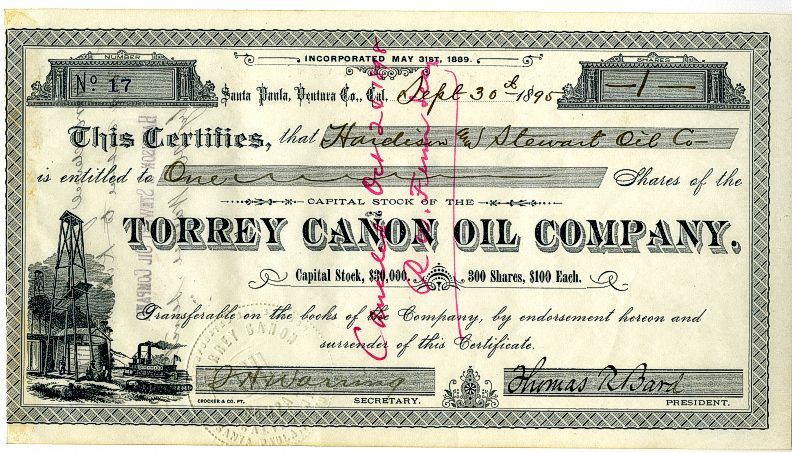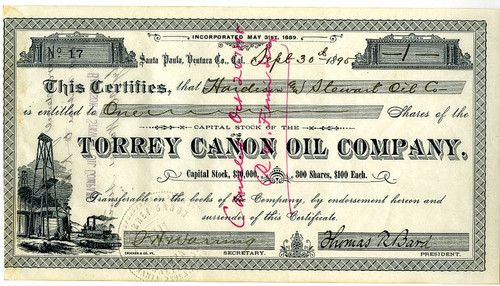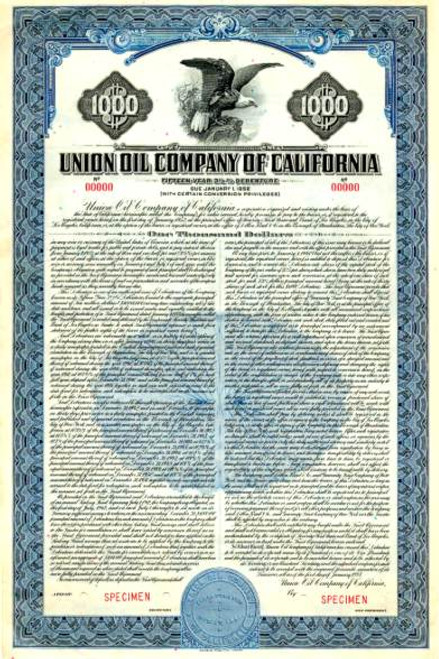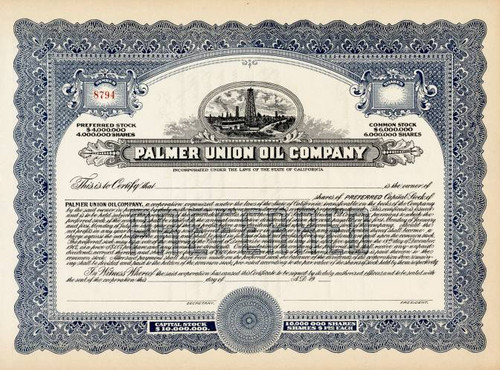Beautiful certificate from the Torrey Canon Oil Company (AKA Torrey Canyon Oil Company) issued in 1895. This historic document was printed by the Crocker & Co. and has an ornate border around it with a vignette of an oil well and a steamboat travelling behind. This item has been hand signed by the Company's President, Thomas R. Bard, and Secretary, Alex Naldie, and is over 130 years old. Stamped cancelled. The certificate was issued to Hardison & Stewart Oil Co. and endorsed on the back by the company's Secretary, Alex Naldie.

Certificate
The Union Oil Company of California was founded on October 17, 1890, in Santa Paula, California, by Lyman Stewart, Thomas Bard, and Wallace Hardison. It was a merger of three Southern Californian oil companies: the Sespe Oil Company and the Torrey Canyon Oil Company (both owned by Bard) and the Hardison and Stewart Oil Company. All three were notable as being completely unaffiliated with Standard Oil. Union Oil moved its headquarters to Los Angeles, in 1901. The original headquarters in Santa Paula is a California Historical Landmark.
“Canyon” comes from the Spanish word cañon, which means “tube” or “pipe.”
Thomas Robert Bard (December 8, 1841 March 5, 1915) was a political leader in California who assisted in the organization of Ventura County and represented the state in the United States Senate from 1900 to 1905 as a Republican. He is known as the "Father of Port Hueneme" for his efforts in building and expanding the city, as well as the first and only deep water port in the area. He is one of the founders of the UNOCAL company. Born in Chambersburg, Franklin County, Pennsylvania on December 8, 1841, Bard attended the common schools, and graduated from the Chambersburg Academy in 1858. He studied law in school, and before his graduation, he secured a job with the Pennsylvania Railroad Company. Later, he became an assistant to the superintendent of the Cumberland Valley Railroad. Other business ventures included the grain business in Hagerstown, Maryland. During the early part of the Civil War, Bard served as a volunteer Union scout during the invasions of Maryland and Pennsylvania by the Confederates. Political career Senator Thomas R. Bard Thomas R. Bard moved to Ventura County, California in 1864 and served as a member of the board of supervisors of Santa Barbara County from 1868 to 1873. In 1871, he was appointed as a commissioner to organize Ventura County. During this time, he purchased and subdivided Rancho El Rio de Santa Clara o la Colonia and laid out the plans for Port Hueneme, California, the future site of his Berylwood estate. Bard would become the first person in California to produce oil from a drilled well. Bard was the California delegate to the 1884 Republican National Convention, and later served as the director of the California state board of agriculture from 1886 to 1887. In 1887, Bard became a founding board member of Occidental College. He was elected as a Republican to the United States Senate to fill a vacancy in the term that began on March 4, 1899. He served from February 7, 1900 to March 3, 1905. Bard was unsuccessful in his 1904 reelection bid. During his term Bard served as the chairman of the Committee of Fisheries (for the Fifty-seventh Congress) and served on the Committee on irrigation (for the Fifty-eighth Congress). One of Thomas R. Bard's notable achievements during his time in office was to appoint George S. Patton, later General Patton, to West Point.
The SS Torrey Canyon named after Torrey Canon Oil Company. The ship sank after running aground on 18 March 1967. SS Torrey Canyon was an LR2 Suezmax class oil tanker with a cargo capacity of 120,000 short tons (110,000 t) of crude oil.She was shipwrecked off the western coast of Cornwall, England, on 18 March 1967, causing an environmental disaster. At that time she was the largest vessel ever to be wrecked. At the time of the shipwreck she was owned by Barracuda Tanker Corporation, a subsidiary of the Union Oil Company of California, and registered in Liberia but chartered to British Petroleum.
Union Oil History About 1910, Union Oil made a strategic alliance with the Independent Producers Agency, a group of small oil producers, to build pipelines from the Kern County oil fields to Union Oil facilities on the Pacific coast. This gave the independent producers an alternative to what they perceived as the low prices paid by Standard Oil and the high freight rates charged by the railroads to move crude oil. It gave Union access to a large volume of crude oil. The situation was later fictionalized in the 2007 film There Will Be Blood. In 1919, the Union Oil Company of Delaware was incorporated as a holding company for the Union Oil Company of California. In 1920, Union Oil purchased the Central Petroleum Company from the Texas Company. In 1922, the Union Oil Associates, Inc. was incorporated in California as a holding company to prevent control of the Union Oil Company of California passing to foreign interests after the merger of the Union Oil Company of Delaware with Royal Dutch Company.[6] In 1961 Union entered into the Indonesian oil market. Henry L. Brandon, Union's Vice President of International Development wrote a "contract of work" arrangement, which was a first for Indonesia. In a speech on Indonesian Independence Day in August, 1961, then President Sukarno talked at some length about "production sharing", which included language written into the contract by Union executives. The company expanded to national status in 1965, when Union Oil merged with the Pure Oil Company, headquartered in what was then Palatine, Illinois, and now Schaumburg, Illinois. Over the next two decades, Union became the major oil producer in southern Alaska and a major natural gas producer in the Gulf of Mexico. The company was reorganized in 1983, and Union Oil Company of California became an operating subsidiary of a new Delaware-based holding company, Unocal Corporation. In 1985, Mesa Petroleum, controlled by billionaire T. Boone Pickens, attempted a takeover of Unocal Corp.[7] that resulted in the Delaware Supreme Court landmark decision Unocal v. Mesa Petroleum, which upheld Unocal's takeover defense. Virtually all operations are conducted by Union Oil Company of California (Union Oil). In 1977, Unocal acquired The Molybdenum Corporation of America (now Molycorp).[8] Among the assets acquired was Mountain Pass rare earth mine, a then world's largest producer of rare earth elements. In 1989, Unocal placed its midwest refining and marketing assets, including Union's 150,000-barrel-per-day (24,000 m3/d) refinery in Lemont, Illinois, into a 50/50 joint venture with Petróleos de Venezuela, S.A. (P.D.V.S.A.). The joint venture, known as the Uno-Ven Company, was headquartered in Arlington Heights, Illinois, and primarily comprising employees from Union Oil's then Schaumburg, Illinois, division headquarters and Lemont, Illinois, refinery. The joint venture was dissolved in 1997, with P.D.V.S.A. receiving full ownership. During the life of the joint venture, the familiar Union 76 brand name continued in full force. At the termination of the joint venture, most stations were converted to Citgo, which is controlled by P.D.V.S.A. In 1990, Unocal entered into a technical collaboration with a multimillion-dollar business house of India M/s Raaj Unocal Lubricants Limited flagship company of Rajgarhia group of Industries via their chairman Late Shri K.L Rajgarhia to manufacture and market Unocal range of Lubricants and greases in India. Unocal subsequently under the provisions of their collaboration agreement granted permission of transferring IP rights to the brand name "UNOCAL 76", "76", "UNOCAL" both collectively and separately to M/s Raaj Unocal Lubricants Limited for Asia to protect their IP rights due to non existence of a bilateral agreement between USA and INDIA on IP rights. In 1997, Unocal sold its western United States refining and marketing operations to Tosco Corporation, including the rights to the Union 76 brand for refining and marketing (except in states where Uno-Ven operated). Tosco was later acquired by Phillips Petroleum, which later merged with Conoco to form ConocoPhillips. Acquisition In April 2005, the United States oil company Chevron made an offer to acquire Unocal, which was followed by a competing bid from the China National Offshore Oil Corporation (CNOOC) on June 22. The final Chevron offer of $17.9 billion was approved by Unocal shareholders August 10.The final CNOOC bid was nearly 5% greater than that of Chevron, but faced significant political opposition from the United States Congress and was finally withdrawn by CNOOC August 2 citing the associated political uncertainty. Following a vote in the United States House of Representatives, the CNOOC bid was referred to President George W. Bush, on the grounds that its implications for national security needed to be reviewed.
To form Union Oil, co-founders Lyman Stewart, Thomas Bard, and Wallace Hardison merged their holdings. Although they could not then have foreseen the tremendous impact the automobile would soon have on oil demand, they were aware of oil's potential as an industrial and transportation fuel. Stewart and Hardison met in the Pennsylvania oil fields, which boomed after the country's first oil well was drilled near Titusville in 1859.
The partners built up modest oil fortunes, then sold out and moved west in the 1880's to seek greater opportunities in California. In 1890, Stewart and Hardison combined their oil assets with those of Thomas Bard, a prominent businessman, to form the Union Oil Company of California. The company was incorporated on October 17, 1890, in the small town of Santa Paula, located about 100 miles northwest of Los Angeles. True entrepreneurs, the three men worked to expand the uses for fuel oil in factories, steamships, and railroads. The company often assigned its own mechanics and technicians to convert power or heating systems to use oil instead of coal in order to demonstrate fuel oil's superiority -- and earn the good will of future customers.
In 1891, Union Oil opened the first petroleum research laboratory west of the Mississippi with the initial aim of developing a process to extract non-smoking kerosene from the heavy California crudes, much less suitable to such use than the lighter, cleaner eastern oils. While the goal eluded Union Oil chemists, that rudimentary lab began a long tradition of research that served the company well. By the turn of the century, only one of the three co-founders remained: Lyman Stewart. In 1901, the company moved its headquarters to Los Angeles -- which Stewart referred to as that "great city of the future." Stewart served as president until 1914, when his son Will stepped into the job. Lyman continued to play an active role as chairman until his death in 1923. Together, father and son guided Union to a position of prominence in the western United States. Recognizing the importance of building an integrated company, the Stewarts created an effective refining and marketing organization backed by a solid resource base. By 1913, there were nearly 123,000 automobiles in California, prompting the company to open its first service station -- or "gas stand" -- on the corner of Sixth and Mateo streets in downtown Los Angeles. As the number of automobiles mushroomed, the company worked hard to keep pace. By 1925, Union had more than 400 service stations on the West Coast In 1930, with the death of Will Stewart, leadership passed to Press St. Clair. As the Great Depression deepened, St. Clair drastically cut back company operations.
The bright spots in that dark decade were the introductions of the first 76 gasoline and Triton motor oil. Both products helped motorists get better performance from their cars, welcome news to those who had to keep their old cars rolling until better times. The 76 marketing symbol was destined to become one of the most recognizable and enduring corporate symbols in the nation. As the world went to war in the late 1930s, Union -- with a dynamic new leader in former steel man Reese Taylor -- beefed up production and refining to pour out fuels to support the Allies. The company's growth continued into the booming postwar era as Union expanded in all directions: discovering the first natural gas in Alaska and the first oil in Australia; taking a lead position in offshore development in the Gulf of Mexico; building a thriving chemicals business; and developing a revolutionary refining technology -- Unicracking -- that became the most widely used in the world. When Reese Taylor died unexpectedly in 1962, Cy Rubel, who had led the expansion in oil and gas exploration and production, came out of retirement to take over. He named a successor, Fred Hartley, two years later. Hartley moved quickly to assure the company's future. In 1965, Union Oil merged with The Pure Oil Company of Illinois, lifting the company from regional to national status with operations in 37 states. The new Union Oil had the financial clout to expand its international petroleum search. In the next 25 years, Union became the major oil producer in southern Alaska and a major natural gas producer in the Gulf of Mexico. Overseas, the company discovered the huge Attaka oil field offshore Indonesia, developed fields in the rugged North Sea and became the world's largest geothermal energy producer. Union made the first commercial discoveries of natural gas in the Gulf of Thailand, helping create a hydrocarbon industry that played a major role in Thailand's economic revolution
In 1983, Union Oil Company of California was reorganized, becoming an operating subsidiary of a new holding company, Unocal Corporation. Two years later, Union began doing business as Unocal. The name quickly gained headline status when the company was targeted for an unfriendly takeover. Unocal survived, but with a heavy burden of debt. When Dick Stegemeier was named president in late 1985, he, Hartley and their executive team faced enormous challenges in streamlining the company. They reduced the debt from $6.1 billion to less than $4 billion by mid-1990. Stegemeier succeeded Hartley, who retired as chairman and CEO before the end of the decade. The 1990s brought mounting competitive challenges to the industry, and Unocal has responded through a ransformation from a mid-sized integrated resource producer, refiner and marketer into one of the world's largest independent oil and gas producers. Roger Beach, named CEO in 1994 and chairman one year later, led this transformation, with a key transition marked by the company's sale of its West Coast refining and marketing assets in 1997.
The sale allowed the company to strengthen its balance sheet and increase investment in growth projects with high potential returns. These include deepwater prospects in the Gulf of Mexico and offshore Indonesia, Brazil and Gabon. The company also has a large position in natural gas-rich Bangladesh. Effective January 1, 2001, Roger Beach retired and Chuck Williamson was named CEO. Williamson, who joined Unocal in 1977, has spent his career in exploration and production, holding senior positions of increasing responsibility in the United Kingdom, The Netherlands, and Thailand. Jack Creighton, 68, former president and CEO of Weyerhaeuser Company, is chairman of the board. The history of Unocal has been marked by tenacity and technological leadership. The company is an fficient finder and producer of oil and gas and a leader in drilling technology. The company's patented formulations for cleaner burning gasoline are helping reduce automobile emissions. Unocal people work in many ways to improve the quality of life in their communities. More than a century go, Lyman Stewart set the tone - working to organize the Union Rescue Mission in Los Angeles and raising money for the local YMCA. He founded the Bible Institute of Los Angeles, which evolved into Biola University. Succeeding generations have followed Stewart's example. Unocal focuses much of its corporate giving on youth around the world. At the time of the company's centennial in 1990, Unocal was one of only 22 surviving industrial companies mong the top 100 companies operating in the early 1900s -- and looked forward to a second century of technological innovation, productive growth, and community leadership. Union Oil Timeline (Unocal) 1890: Union Oil formed in California by merger of Hardison & Stewart Oil Company, the Sespe Oil Company, and the Torrey Canyon Oil Company 1917: Union purchases Pinal-Dome Oil Company 1922: Shell buys 25% of Union Oil of California 1922: Shell Union Oil Corporation formed to consolidate Shell interests in the US with those of the Union Oil Company of Delaware 1965: Union acquires Pure Oil 1983: Union Oil changes name to Unocal 1992: Ashland Chemical acquires most of Unocal's chemical distribution business, establishing the IC&S Division Acquisition In April 2005, the United States oil company Chevron made an offer to acquire Unocal, which was followed by a competing bid from the China National Offshore Oil Corporation (CNOOC) on June 22. The final Chevron offer of $17.9 billion was approved by Unocal shareholders August 10.The final CNOOC bid was nearly 5% greater than that of Chevron, but faced significant political opposition from the United States Congress and was finally withdrawn by CNOOC August 2 citing the associated political uncertainty. Following a vote in the United States House of Representatives, the CNOOC bid was referred to President George W. Bush, on the grounds that its implications for national security needed to be reviewed.
Port Hueneme is a small beach city in Ventura County, California surrounded by the city of Oxnard and the Santa Barbara Channel. The name derives from the Spanish spelling of the Ventureño phrase wene me, meaning "Resting Place". The town's name was officially changed to Port Hueneme in 1939 and was incorporated March 24, 1948. Both the Port of Hueneme and Naval Base Ventura County lie within city limits. Thomas Bard learned of the submarine canyon at Point Hueneme[ and took advantage of the canyon depth to construct the Hueneme Wharf in 1871. The existing street grid of the town was formally laid out in 1888. Until the construction of the Montalvo Cutoff that brought the railroad to nearby Oxnard, the wharf was the principal means of transportation for that portion of Ventura County lying south of the Santa Clara River. Hueneme was the second largest grain shipping port on the Pacific coast between 1871 and 1895. History from Union Oil Company, Encyberpedia and OldCompany.com (old stock certificate research service)








